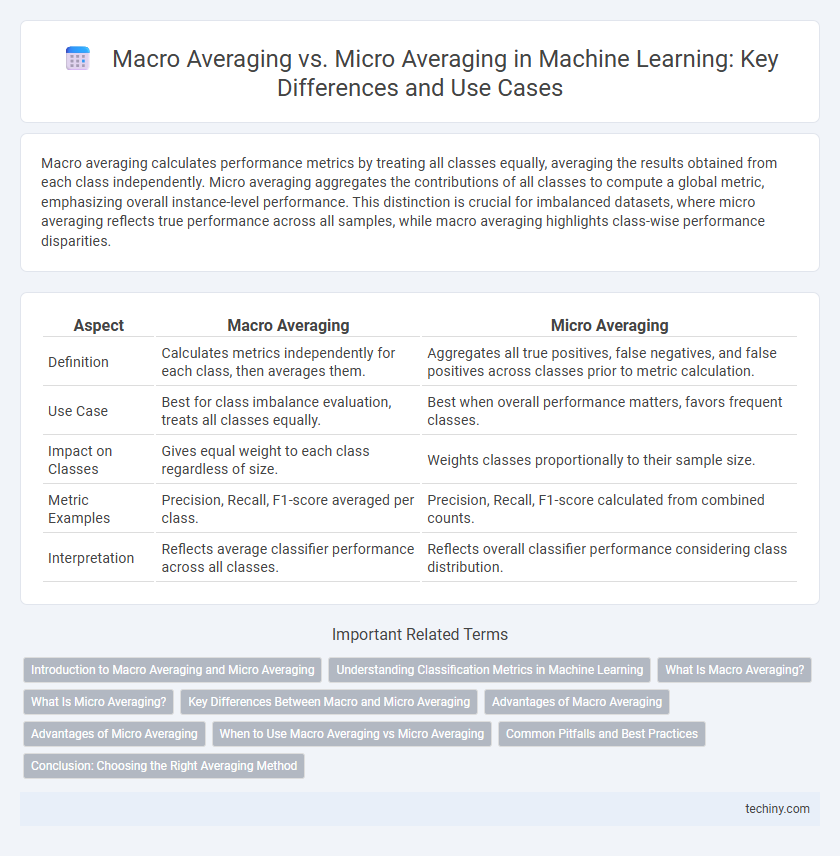Macro averaging calculates performance metrics by treating all classes equally, averaging the results obtained from each class independently. Micro averaging aggregates the contributions of all classes to compute a global metric, emphasizing overall instance-level performance. This distinction is crucial for imbalanced datasets, where micro averaging reflects true performance across all samples, while macro averaging highlights class-wise performance disparities.
Table of Comparison
| Aspect | Macro Averaging | Micro Averaging |
|---|---|---|
| Definition | Calculates metrics independently for each class, then averages them. | Aggregates all true positives, false negatives, and false positives across classes prior to metric calculation. |
| Use Case | Best for class imbalance evaluation, treats all classes equally. | Best when overall performance matters, favors frequent classes. |
| Impact on Classes | Gives equal weight to each class regardless of size. | Weights classes proportionally to their sample size. |
| Metric Examples | Precision, Recall, F1-score averaged per class. | Precision, Recall, F1-score calculated from combined counts. |
| Interpretation | Reflects average classifier performance across all classes. | Reflects overall classifier performance considering class distribution. |
Introduction to Macro Averaging and Micro Averaging
Macro averaging calculates performance metrics independently for each class and then averages the results, treating all classes equally regardless of their support or frequency. Micro averaging aggregates the contributions of all classes to compute a global performance metric, giving more weight to classes with more instances. These techniques are crucial in evaluating multi-class classification models, especially when dealing with imbalanced datasets.
Understanding Classification Metrics in Machine Learning
Macro averaging calculates the metric independently for each class and then takes the average, treating all classes equally regardless of their size, which is crucial for imbalanced datasets. Micro averaging aggregates the contributions of all classes to compute the average metric, giving more weight to larger classes by considering total true positives, false negatives, and false positives. Understanding the differences between macro and micro averaging enables better evaluation of classification models, especially in scenarios with class imbalance.
What Is Macro Averaging?
Macro averaging in machine learning evaluates model performance by calculating metrics independently for each class and then averaging these scores, giving equal weight to all classes regardless of their size. This approach ensures balanced assessment in multi-class classification tasks, particularly when dealing with imbalanced datasets. Macro averaging provides insights into the model's ability to perform well across all classes without being biased towards the more frequent ones.
What Is Micro Averaging?
Micro averaging in machine learning aggregates the contributions of all classes to compute a global precision, recall, or F1-score by counting total true positives, false negatives, and false positives across classes. This method treats each individual prediction equally, making it especially useful for imbalanced datasets where some classes have significantly fewer instances. Micro averaging provides an overall performance measure that reflects the proportion of correctly classified instances regardless of class distribution.
Key Differences Between Macro and Micro Averaging
Macro averaging calculates metrics independently for each class and then averages them, treating all classes equally regardless of their size. Micro averaging aggregates the contributions of all classes to compute the average metric globally, favoring classes with more samples. Key differences include macro averaging emphasizing class balance by treating all classes equally, while micro averaging accounts for class imbalance by weighting classes according to their sample sizes.
Advantages of Macro Averaging
Macro averaging evaluates each class independently and calculates the average performance, ensuring that minority classes have equal impact on the overall metric. This approach provides a balanced measure in imbalanced datasets by avoiding bias towards majority classes and allowing fair comparison across all categories. Macro averaging is especially beneficial in multi-class classification where identifying performance on less frequent classes is critical for comprehensive model assessment.
Advantages of Micro Averaging
Micro averaging computes overall precision, recall, and F1-score by aggregating true positives, false positives, and false negatives across all classes, which provides a more accurate measure for imbalanced datasets. It emphasizes individual data points, ensuring that larger classes have a greater influence on the performance metric, leading to a balanced evaluation in multi-class classification problems. This approach is particularly advantageous when the goal is to assess the model's ability to perform well across all instances rather than equally across all classes.
When to Use Macro Averaging vs Micro Averaging
Macro averaging is preferred when evaluating models on imbalanced datasets, as it treats all classes equally by calculating metrics independently for each class before averaging, highlighting performance on minority classes. Micro averaging is suitable for overall model performance assessment, aggregating contributions of all classes to compute global metrics, thus favoring classes with larger sample sizes. Use macro averaging to gain insights into per-class performance and micro averaging for assessing aggregate classification effectiveness.
Common Pitfalls and Best Practices
Macro averaging treats each class equally and can misrepresent performance when class distribution is imbalanced, leading to overestimated accuracy in rare classes. Micro averaging aggregates contributions of all classes to compute a global metric, better reflecting overall model performance but potentially masking poor results in minority classes. Best practices suggest using both metrics together to gain balanced insights, especially in multi-class imbalanced datasets, while carefully interpreting results to avoid misleading conclusions.
Conclusion: Choosing the Right Averaging Method
Choosing between macro averaging and micro averaging depends on the specific machine learning task and dataset characteristics. Macro averaging treats all classes equally by averaging metrics independently, making it ideal for imbalanced datasets where performance across minority classes matters. Micro averaging aggregates contributions from all classes to compute a global metric, providing a more balanced performance measure when class distribution is uniform or overall accuracy is the priority.
Macro Averaging vs Micro Averaging Infographic

 techiny.com
techiny.com